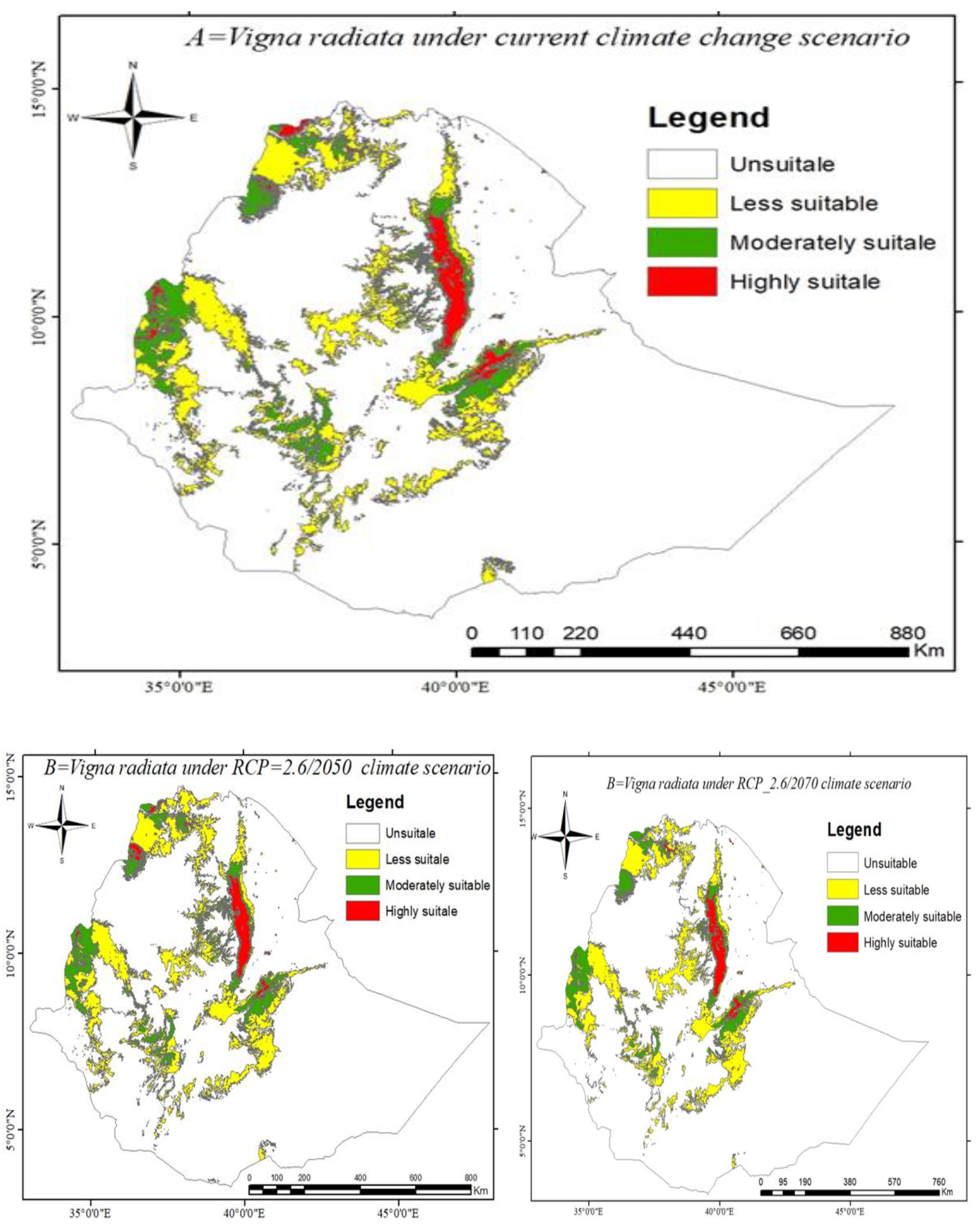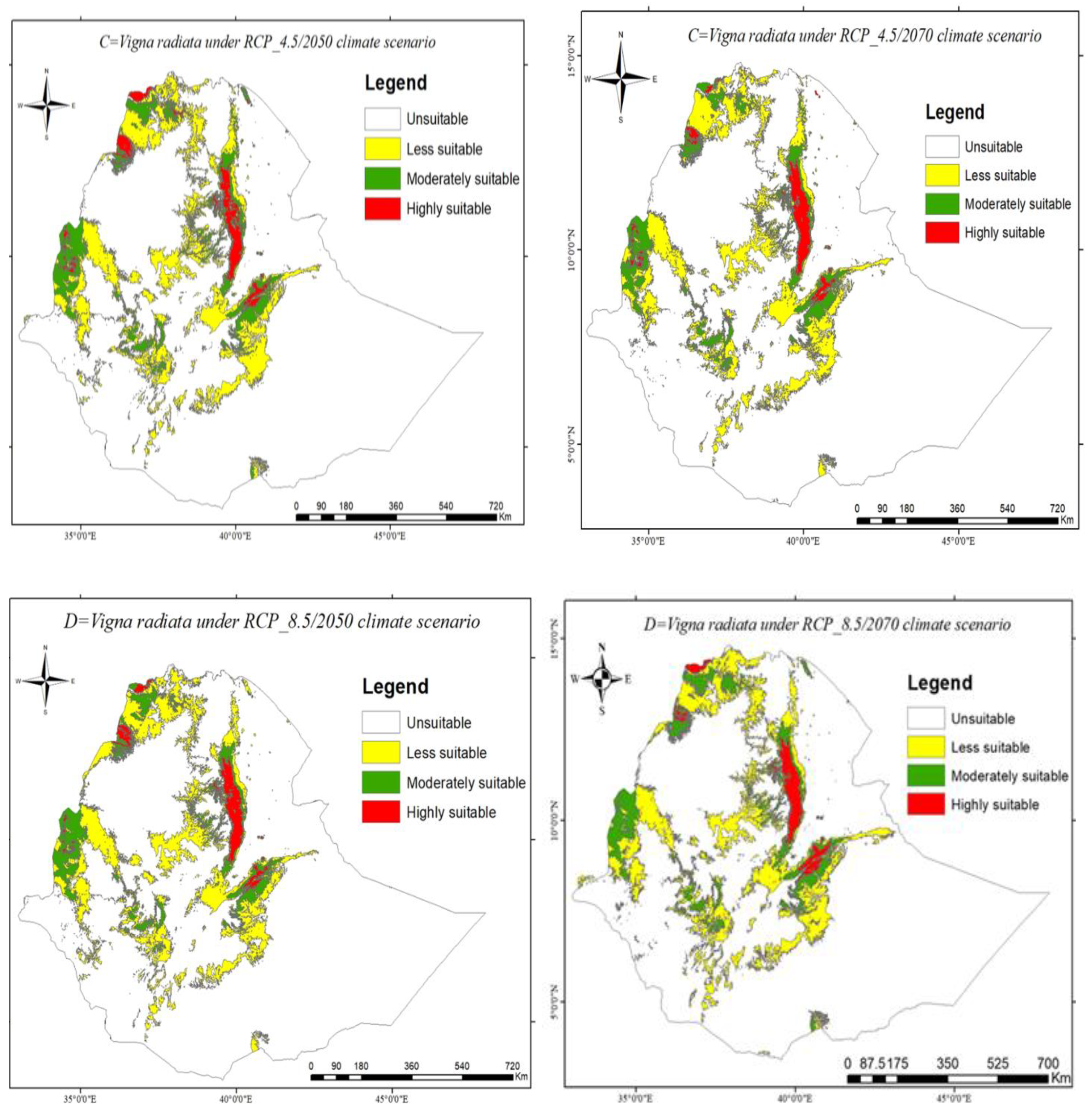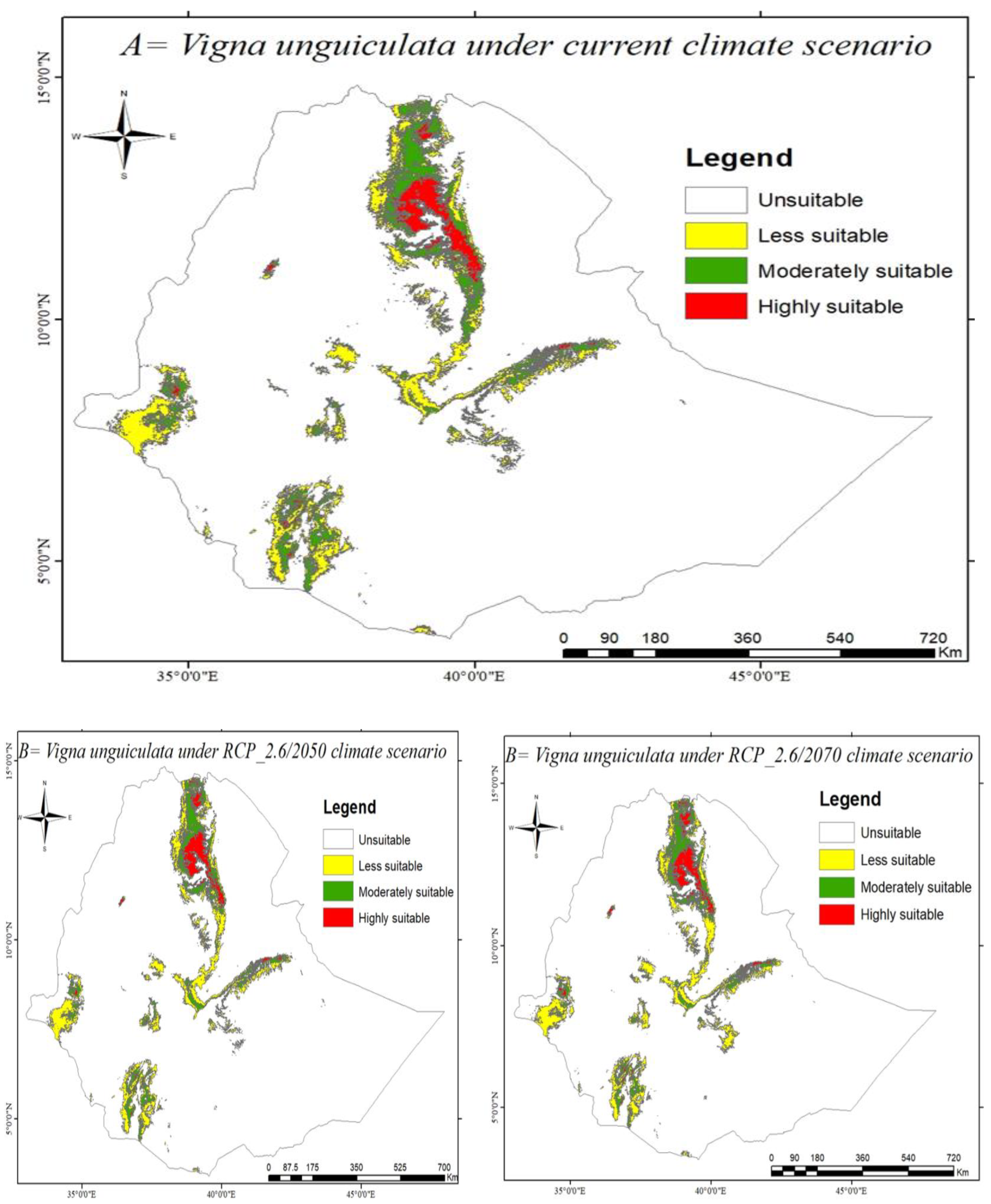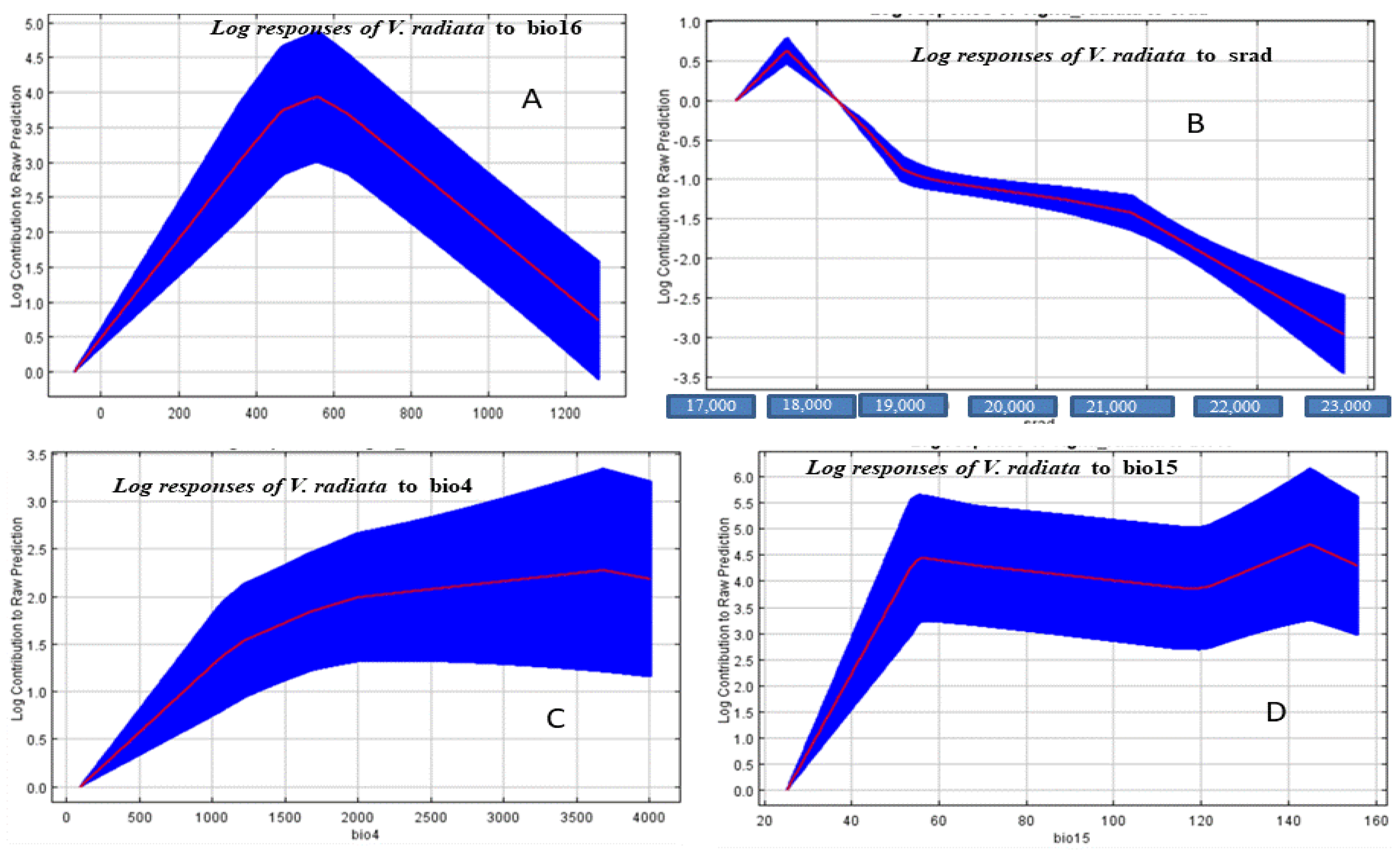Modeling the Impact of Climate Change on Sustainable Production of Two Legumes Important Economically and for Food Security: Mungbeans and Cowpeas in Ethiopia
Abstract
1. Introduction
2. Method and Materials
Study Area
3. Data Collection
Species Occurrence
4. Bioclimatic Variables
5. Environmental Variable Selection for Modeling
6. Data Analysis
7. Evaluation of Model Performance and Simulation
8. Result
8.1. Environmental Variable Contributions for Mungbeans and Cowpea Distribution in Ethiopia
8.2. Current Distribution of Mungbeans and Cowpea in Ethiopia
8.3. Future Projected Distributions of Mungbeans and Cowpea Crops in Ethiopia
8.4. Geographical Distribution and Species Response to the Environmental Variables
9. Discussions
10. Conclusions
Supplementary Materials
Author Contributions
Funding
Institutional Review Board Statement
Informed Consent Statement
Data Availability Statement
Acknowledgments
Conflicts of Interest
References
- Tesfaye, K.; Mamo, G.; Debela, S.; Tadesse, M.; Mekuriaw, A.; Debele, B.; Semane, B.; Gebrekidan, B.; Lemenih, M.; Zenebe, M. First Assessment Report on Agriculture and Food Security. Working Group II—Climate Change Impact, Vulnerability, Adaptation, and Mitigation; Ethiopian Academy of Sciences (EAS): Addis Ababa, Ethiopia, 2015; p. 230. [Google Scholar]
- IPCC (Intergovernmental Panel on Climate Change). Climate Change 2007–The Physical Science Basis; Cambridge University Press: Cambridge, UK, 2007. [Google Scholar]
- Jones, P.G.; Thornton, P.K. The potential impacts of climate change on maize production in Africa and Latin America in 2005. Glob. Environ. Chang. 2009, 13, 51–59. [Google Scholar] [CrossRef]
- Conway, D.; Schipper, E.L.F. Adaptation to climate change in Africa: Challenges and opportunities identified from Ethiopia. Glob. Environ. 2014, 21, 227–237. [Google Scholar] [CrossRef]
- Demeke, A.B.; Keil, A.; Zeller, M. Using panel data to estimate the effect of rainfall shocks on smallholders’ food security and vulnerability in rural Ethiopia. Clim. Chang. 2011, 108, 185–206. [Google Scholar] [CrossRef]
- Araya, A.; Stroosnijder, L.; Habtu, S.; Keesstra, S.D.; Berhe, M.; Hadgu, K.M. Risk assessment by sowing date for barley (Hordeum vulgare) in northern Ethiopia. Agric. For. Meteorol. 2012, 154, 30–37. [Google Scholar] [CrossRef]
- Deresa, T.T. Measuring the Economic Impact of Climate Change on Ethiopian Agriculture. Centre for Environmental Economics and Policy in Africa, University of Pretoria; Ethiopian Revenue and Custom Authority (ERCA): Addis Ababa, Ethiopia, 2006.
- Central Statistical Agency (CSA). Agricultural Sample Survey Report on Area and Production of Crops (Private Peasant Holdings ‘Meher’ Season); Central Statistical Agency (CSA): Addis Ababa, Ethiopia, 2016.
- Araújo, M.B.; Pearson, R.G.; Thuiller, W.; Erhard, M. Validation of species—climate impact models under climate change. Glob. Chang. Biol. 2005, 11, 1504–1513. [Google Scholar] [CrossRef]
- Elith, J.; Leathwick, J.R. Species distribution models ecological explanation and prediction across space and time. Annu. Rev. Ecol. Evol. Syst. 2009, 40, 677–697. [Google Scholar] [CrossRef]
- Guisan, A.; Zimmermann, N.E. Predictive habitat distribution models in ecology. Ecol. Model. 2000, 135, 147–186. [Google Scholar] [CrossRef]
- Carpenter, G.; Gillison, A.N.; Winter, J. DOMAIN: A flexible modelling procedure for mapping potential distributions of plants and animals. Biodivers. Conserv. 1993, 2, 667–680. [Google Scholar] [CrossRef]
- Stockman, A.K.; Beamer, D.A.; Bond, J.E. An Evaluation of a GARP Model as an Approach to Predicting the Spatial Distribution of Non-Vagile Invertebrate Species. Divers. Distrib. 2006, 12, 81–89. [Google Scholar] [CrossRef]
- Phillipsa, S.J.; Andersonb, R.P.; Schapire, R.E. Maximum entropy modeling of species geographic distributions. Ecol. Model. 2006, 190, 231–259. [Google Scholar] [CrossRef]
- Hussein, A.; Workeneh, S. Modeling the Impacts of Climate Changes on the Distribution of Aloe Vera Species in Ethiopia. J. Earth Sci. Clim. Chang. 2021, 12, 567. [Google Scholar]
- Qiao, H.; Soberón, J.; Peterson, A.T. No silver bullets in correlative ecological niche modelling insights from testing among many potential algorithms for niche estimation. Meth. Ecol. Evol. 2015, 6, 1126–1136. [Google Scholar] [CrossRef]
- Porfirio, L.L.; Harris, R.M.; Lefroy, E.C.; Hugh, S.; Gould, S.F.; Lee, G.; Bindoff, N.L.; Mackey, B. Improving the use of species distribution models in conservation planning and management under climate change. PLoS ONE 2014, 9, e113749. [Google Scholar] [CrossRef] [PubMed]
- Lim, T.K. Edible Medicinal and Non-Medicinal Plants Fruits; Springer: Dordrecht, Germany; Berlin/Heidelberg, Germany; London, UK; New York, NY, USA, 2012; Volume 2, pp. 966–967. [Google Scholar]
- Lambrides, C.J.; Godwin, I. Mungbean. In Genome Mapping and Molecular Breeding in Plants Pulses, Sugar and Tuber Crops; Kole, C., Ed.; Springer: Berlin/Heidelberg, Germany, 2007; Volume 3, pp. 69–90. [Google Scholar]
- Shi, Z.; Yao, Y.; Zhu, Y.; Ren, G. Nutritional composition and antioxidantactivity of twenty mung bean cultivars in China. Crop J. 2016, 4, 398–406. [Google Scholar] [CrossRef]
- Liu, C.Y.; Chen, X.Z.; Wang, S.H.; Wang, L.X.; Sun, L.; Mei, L.; Xu, N. The genetic diversity of mungbean germplasm in China. J. Plant Genet. Resour. 2006, 7, 459–463. [Google Scholar]
- Rahman, M.; Bhuiyan, M.; Sutradhar, G.; Rahman, M.; Paul, A. Effect of phosphorus, molybdenum and rhizobium inoculation on yield and yield attributes of mungbean. Int. J. Sust. Crop Prod. 2008, 3, 26–33. [Google Scholar]
- Khan, M.A.; Naveed, K.; Ali, K.; Bashir, A.; Samin, J. Impact of mungbean-maize intercropping on growth and yield of mungbean. Pak. J. Weed Sci. Res. 2012, 18, 191–200. [Google Scholar]
- Anjum, M.S.; Ahmed, Z.I.; Rauf, C.A. Effect of rhizobium inoculation and nitrogen fertilizer on yield and yield components of mungbean. Int. J. Agric. Biol. 2006, 8, 238–240. [Google Scholar]
- Ayalew, T. Mungbean (Vigna radiata (L.) Wilczek) (Fabaceae) Landrace Diversity in Ethiopia. Master’s Thesis, Addis Ababa University, Addis Ababa, Ethiopia, 2015. [Google Scholar]
- Yagoob, H.; Yagoob, M. The effects of water deficit stress on protein yield of mungbean genotypes. Peak J. Agri. Sci. 2014, 2, 30–35. [Google Scholar]
- CSA (Central Statistical Authority). Report on the Preliminary Results of Area, Production and Yield of Temporary Crops in Ethiopia; CSA: Addis Ababa, Ethiopia, 2018.
- Asfaw, A.; Gurum, F.; Alemayehu, F.; Rezene, Y. Analysis of multi environment grain yield trials in mungbean (Vigna radiata L.) Wilczek based on GGE bipot in Southern Ethiopia. J. Agric. Sci. Technol. 2012, 14, 389–398. [Google Scholar]
- Das, S.; Shekhar, U.D.; Ghosh, P. Assessment of molecular genetic diversity in some green gram cultivars as revealed by ISSR analysis. Adv. Appl. Sci. Res. 2014, 5, 93–97. [Google Scholar]
- Erana, K.; Zelalem, B. Expounding the production and importance of cowpea (Vigna unguiculata (L.) Walp.) in Ethiopia. Cogent Food Agric. 2020, 6, 1769805. [Google Scholar] [CrossRef]
- Kamara, A.Y.; Omoigui, L.O.; Kamai, N.; Ewansiha, S.U.; Ajeigbe, H.A. Improving Cultivation of Cowpea in West Africa. In Achieving Sustainable Cultivation of Grain Legumes; Sivasankar, S., Bergvinson, D., Gaur, P., Kumar, S., Beebe, S., Tamò, M., Eds.; Burleigh Dodds Science Publishing Limited: Cambridge, UK, 2018; Volume 2, pp. 235–252. [Google Scholar]
- Mulugeta, A.; Zemede, A.; Zerihun, W.; Berhanu, A.F.; Beth, M. Cowpea (Vigna unguiculata (L.) Walp.) (Fabaceae) landrace diversity in northern Ethiopia. Int. J. Biodi. Conserv. 2016, 8, 297–309. [Google Scholar] [CrossRef]
- Ojiewo, C.O.; Omoigui, L.O.; Pasupuleti, J.; Lenné, J.M. Grain legume seed systems for smallholder farmers: Perspectives on successful innovations. Outlook Agric. 2020, 49, 286–292. [Google Scholar] [CrossRef]
- Sisay, A.; Mulugeta, A.; Zemede, A.; Woldu, Z.; Berhanu, A. Cowpea (Vigna unguiculata (L.)Walp., Fabaceae) landrace (local farmers’ varieties) diversity and ethnobotany in Southwestern and Eastern parts of Ethiopia. Afr. J. Agric. Res. 2019, 14, 1029–1041. [Google Scholar] [CrossRef]
- Carneiro da Silva, A.; da Costa Santos, D.; Junior, L.T.; Silva, P.B.; Santos, R.C.; Siviero, A. Cowpea: A strategic legume species for food security and health. In Legume Seed Nutraceutical Research; Jimenez-Lopez, J.C., Clemente, A., Eds.; IntechOpen: London, UK, 2018; pp. 47–65. [Google Scholar] [CrossRef]
- Sisay, A. Cowpea (Vigna unguiculata (L.) Walp.) (Fabaceae) Landrace Diversity in southern Ethiopia. Master’s Thesis, Addis Ababa University, Addis Ababa, Ethiopia, 2015. [Google Scholar]
- Jaiswal, D.K.; Krishna, R.; Chouhan, G.K.; Pereira, A.P.D.A.; Ade, A.B.; Prakash, S.; Verma, S.K.; Prasad, R.; Yadav, J.; Verma, J.P. Bio-fortification of minerals in crops: Current scenario and future prospects for sustainable agriculture and human health. Plant Growth Regul. 2022, 98, 5–22. [Google Scholar] [CrossRef]
- Food and Agriculture Organization Corporate Statistical Database (FAOSTAT)). Food and Agriculture Organization of the United Nations Statistics Division. 2016. Available online: http://faostat3.fao.org/download/Q/QC/E (accessed on 31 December 2016).
- Beshir, B.; Amsalu, B.; Dagmawit, T.; Selamawit, K.; Teamir, M.; Bezawit, Y. Cowpea Production, Marketing and Utilization in Ethiopia (Research Report 121). 2019. Available online: https://www.researchgate.net/publication/341042797_Cowpea_Production_Marketing_and_Utilization_in_Ethiopia (accessed on 12 April 2022). [CrossRef]
- Bilatu, A.; Binyam, K.; Solomon, Z.; Eskinder, A.; Ferede, A. Animal feed potential and adaptability of some cowpea (Vigna unguiculata) varieties in North West lowlands of Ethiopia. J. Agri. Res. 2012, 1, 478–483. [Google Scholar]
- Chan, L.M.; Brown, J.L.; Yoder, A.D. Integrating statistical genetic and geospatial methods brings new power to phylogeography. Mol. Phylogenet. Evol. 2011, 59, 523–537. [Google Scholar] [CrossRef]
- Bloom, T.D.; Flower, A.; DeChaine, E.G. Why georeferencing matters: Introducing a practical protocol to prepare species occurrence records for spatial analysis. Ecol. Evol. 2018, 8, 765–777. [Google Scholar] [CrossRef]
- Murphey, P.C.; Guralnick, R.P.; Glaubitz, R.; Neufeld, D.; Ryan, J.A. Georeferencing of museum collections: A review of problems and automated tools, and the methodology developed by the mountain and plains spatiotemporal database-informatics initiative (Mapstedi). PhyloInformatics 2004, 3, 1–29. [Google Scholar]
- Van Proosdij, A.S.; Sosef, M.S.; Wieringa, J.J.; Raes, N. Minimum required number of specimen records to develop accurate species distribution models. Ecography 2016, 39, 542–552. [Google Scholar] [CrossRef]
- Støa, B.; Halvorsen, R.; Stokland, J.N.; Gusarov, V.I. How much is enough? Influence of number of presence observations on the performance of species distribution models. Sommerfeltia 2019, 39, 1–28. [Google Scholar]
- Brown, J.L. SDMtoolbox: A python-based GIS toolkit for landscape genetic, biogeographic and species distribution model analyses. Methods Ecol. Evol. 2014, 5, 694–700. [Google Scholar] [CrossRef]
- Hijmans, R.J.; Cameron, S.E.; Parra, J.L.; Jones, P.G.; Jarvis, A. Very high resolution interpolated climate surfaces for global land areas. Int. J. Climatol. 2005, 25, 1965–1978. [Google Scholar] [CrossRef]
- Weyant, J.; Azar, C.; Kainuma, M.; Kejun, J.; Nakicenovic, N.; Shukla, P.R.; Rovere, E.L.; Yohe, G. Report of 2.6 Versus 2.9 Watts/m2 RCPP Evaluation Panel. IPCC Secretariat: Geneva, Switzerland, 2009. [Google Scholar]
- Intergovernmental Panel on Climate Change (IPCC). Climate Change and Water; Technical Paper of the Intergovernmental Panel on Climate Change; IPCC Secretariat: Geneva, Switzerland, 2008; p. 210. [Google Scholar]
- Baldwin, R.A. Use of maximum entropy modeling in wildlife research. Entropy 2009, 11, 854–866. [Google Scholar] [CrossRef]
- Van, H.A.; Conti, F.; Ciaschetti, G.; Westinga, E. Fine resolution distribution modeling of endemics in Majella National Park, Central Italy. Plant Biosyst. Int. J. Deal. All Asps. Plant Biol. 2012, 146, 276–287. [Google Scholar]
- Zhao, X.; Ren, B.; Li, D.; Garber, P.A.; Zhu, P.; Xiang, Z. Climate change, grazing, and collecting accelerate habitat contraction in an endangered primate. Biol. Conserv. 2019, 231, 88–97. [Google Scholar] [CrossRef]
- Guisan, A.; Thuiller, W.; Zimmermann, N.E. Habitat Suitability and Distribution Models: With Applications in R; Cambridge University Press: Cambridge, UK, 2017. [Google Scholar]
- Yoon, S.; Lee, W.H. Methodological analysis of bioclimatic variable selection in species distribution modeling with application to agricultural pests (Metcalfa pruinosa and Spodoptera litura). Comput. Electron. Agric. 2021, 190, 106430. [Google Scholar] [CrossRef]
- Montgomery, P. An Introduction to Statistical Modelling. Technometrics 1992, 42, 435–436. [Google Scholar]
- Fick, S.E.; Hijmans, R.J. WorldClim 2: New 1 km Spatial Resolution climate Surfaces for Global GBIF.org. 2017. Available online: https://www.gbif.org/occurrence/download/0223934-210914110416597 (accessed on 15 April 2022).
- Steven, J.; Phillips, M.; Robert, E.S. Maxent Software for Modeling Species Niches and Distributions (Version 3.4.4). Available online: https://biodiversityinformatics.amnh.org/open_source/maxent/ (accessed on 12 December 2022).
- Yang, X.Q.; Kushwaha, S.P.S.; Saran, S.; Xu, J.; Roy, P.S. Maxent modeling for predicting the potential distribution of medicinal plant, Justicia adhatoda L in Lesser Himalayan foothills. Ecol. Eng. 2013, 51, 83–87. [Google Scholar] [CrossRef]
- Antúnez, P.; Suárez-Mota, M.E.; Valenzuela-Encinas, C.; Ruiz-Aquino, F. The Potential Distribution of Tree Species in Three Periods of Time under a Climate Change Scenario. Forests 2018, 9, 628. [Google Scholar] [CrossRef]
- Phillips, S.J.; Dud’ık, M.; Schapire, R.E. A maximum entropy approach to species distribution modeling. In Proceedings of the 21st International Conference on Machine Learning, Banff, AB, Canada, 4–8 July 2004; pp. 655–662. [Google Scholar]
- Enkossa, T.; Nemomissa, S.; Lemessa, D. Predicting the potential suitable habitats of forest spices Piper capense and Aframomum corrorima under climate change in Ethiopia. J. Trop. Ecol. 2022, 38, 219–232. [Google Scholar] [CrossRef]
- Liu, C.; Berry, P.M.; Dawson, T.P.; Pearson, R.G. Selecting thresholds of occurrence in the prediction of species distributions. Ecography 2005, 28, 385–393. [Google Scholar] [CrossRef]
- Swets, J.A. Measuring the accuracy of diagnostic systems. Science 1988, 240, 1285–1293. [Google Scholar] [CrossRef] [PubMed]
- Trew, B.T.; Maclean, I.M.D. Vulnerability of global biodiversity hotspots to climate change. Glob. Ecol. Biogeogr. 2021, 30, 768–783. [Google Scholar] [CrossRef]
- Purvis, A.; Gittleman, J.L.; Cowlishaw, G.; Mace, G.M. Predicting extinction risk in declining species. Proc. R. Soc. London Ser. B Biol. Sci. 2002, 67, 1947–1952. [Google Scholar] [CrossRef]
- Louppe, D.; Oteng-Amoaka, A.A.; Brink, M. Plant resources of tropical Africa. Prota 2008, 7, 562–563. [Google Scholar]
- Tchoundjeu, Z.; Atangana, A.R. Irvingia gabonensis (Aubry-Lecomte ex ’Rorke) Baill. In Record from Protabase; Van der Vossen, H.A.M., Mkamilo, G.S., Eds.; Prota: Wageningen, The Netherlands, 2011. [Google Scholar]
- Khanum, R.; Mumtaz, A.S.; Kumar, S. Predicting impacts of climate change on medicinal asclepiads of Pakistan using Maxent modeling. Acta Oecol. 2013, 49, 23–31. [Google Scholar] [CrossRef]
- Umata, H. Evaluation of Adaptability of Mung Bean Varieties in Moisture Stress of Eastern Harerghe Zone. Agric. Res. Technol. 2018, 13, 555880. [Google Scholar] [CrossRef]
- Zare, M.; Dehghani, B.; Alizadeh, O.; Azarpanah, A. The evaluation of various agronomic traits of mungbean (Vigna radiate L.) genotypes under drought stress and non-stress conditions. Int. J. Farming Allied Sci. 2013, 2, 764–770. [Google Scholar]
- Karim, A.; Fukamachi, H.; Hidaka, T. Photosynthetic performance of Vigna radiata L. leaves developed at different temperature and irradiance levels. Plant Sci. 2003, 164, 451–458. [Google Scholar]
- Keating, K.A.; Gogan, P.J.; Vore, J.M.; Irby, L.R. A simple solar radiation index for wildlife habitat studies. J. Wildl. Manag. 2007, 71, 1344–1348. [Google Scholar] [CrossRef]
- Ashinie, S.K.; Tesfaye, B.; Wakeyo, G.K.; Fenta, B.A. Genetic diversity for immature pod traits in Ethiopian cowpea [Vigna unguiculata (L.) Walp.] Landrace collections. Afr. J. Biotechnol. 2020, 19, 171–182. [Google Scholar]
- Etana, A.; Tadesse, E.; Mengistu, A.; Hassen, A. Advanced evaluation of cowpea (Vigna unguiculata) accessions for fodder production in the central rift valley of Ethiopia. J. Agric. Extens. Rural Dev. 2013, 5, 55–61. [Google Scholar]
- Ayalew, T.; Yoseph, T. Cowpea (Vigna unguiculata L. Walp.): A choice crop for sustainability during the climate change periods. J. Appl. Biol. Biotechnol. 2022, 10, 154–162. [Google Scholar] [CrossRef]
- Rogers, A.; Gibon, Y.; Stitt, M.; Morgan, P.B.; Bernacchi, C.J.; Ort, D.R. Increased C availability at elevated carbon dioxide concentration improves N assimilation in a legume. Plant Cell Environ. 2006, 29, 1651–1658. [Google Scholar] [CrossRef]
- Magadza, C. Climate change impacts and human settlements in Africa: Prospects for adaptation. Environ. Monit Assess 2000, 61, 193–205. [Google Scholar] [CrossRef]
- Hungria, M.; Franco, A.; Sprent, J. New sources of high-temperature tolerant rhizobia for Phaseolus vulgaris L. Plant Soil 1993, 149, 103–109. [Google Scholar] [CrossRef]
- McNamara, A.; Hill, W. UV-B irradiance gradient affects photosynthesis and pigments but not food quality of perihyton. Fresh Water Biol. 2000, 43, 649–662. [Google Scholar] [CrossRef]
- Boukar, O.; Belko, N.; Chamarthi, S.; Togola, A.; Batieno, J.; Fatokun, C. Cowpea (Vigna unguiculata): Genetics, genomics and breeding. Plant Breed. 2018, 138, 415–424. [Google Scholar] [CrossRef]








| Contribution Percentage of Environmental Variables | |||||||||||||
|---|---|---|---|---|---|---|---|---|---|---|---|---|---|
| Species | Periods | RCPs | Bio 2 | Bio 3 | Bio 4 | Bio 8 | Bio 15 | Bio16 | Bio17 | Bio18 | Bio19 | SRI | Elv |
| Vigna radiata | Current | - | 2.2 | 0.2 | 7.5 | 6.5 | 8.1 | 32.9 | 3.0 | 3.3 | 7.3 | 19.5 | 9.5 |
| 2050 | 2.6 | 2.8 | 0.2 | 6.8 | 6.7 | 5.4 | 35.0 | 2.7 | 5.1 | 5.9 | 19.1 | 10.3 | |
| 4.5 | 2.0 | 0.1 | 10.1 | 5.1 | 5.9 | 32.3 | 3.7 | 7.3 | 7.4 | 16.9 | 9.2 | ||
| 8.5 | 2.2 | 0.2 | 9.0 | 6.2 | 5.8 | 36.3 | 3.4 | 6.6 | 5.3 | 18.5 | 6.4 | ||
| 2070 | 2.6 | 4.5 | 0.1 | 8.5 | 7.0 | 6.3 | 31.0 | 2.6 | 6.3 | 4.4 | 21.0 | 8.2 | |
| 4.5 | 1.3 | 0.8 | 8.8 | 7.4 | 6.9 | 30.4 | 3.0 | 7.0 | 7.0 | 17.5 | 10.0 | ||
| 8.5 | 1.4 | 0.7 | 10.4 | 6.5 | 6.3 | 37.3 | 4.0 | 7.6 | 4.3 | 15.1 | 6.4 | ||
| Periods | RCPs | Bio3 | Bio4 | Bio7 | Bio8 | Bio16 | Bio17 | Bio18 | Bio19 | SRI | Elv | ||
| Vigna unguiculata | Current | - | 0.4 | 19.5 | 15.4 | 1.6 | 29.4 | 14.1 | 0.8 | 12.6 | 0.9 | 5.3 | |
| 2050 | 2.6 | 0.3 | 19.4 | 14.5 | 2.0 | 31.3 | 13.1 | 0.6 | 12.5 | 0.6 | 5.9 | ||
| 4.5 | 0.3 | 19.6 | 13.8 | 2.0 | 36.1 | 12.0 | 0.8 | 9.1 | 1.0 | 5.3 | |||
| 8.5 | 0.4 | 18.9 | 15.5 | 0.5 | 33.2 | 13.9 | 0.8 | 10.5 | 0.8 | 5.5 | |||
| 2070 | 2.6 | 0.9 | 17.9 | 15.1 | 1.3 | 35.9 | 12.8 | 0.8 | 8.5 | 0.4 | 6.4 | ||
| 4.5 | 1.1 | 18.5 | 14.9 | 1.4 | 33.3 | 12.1 | 0.5 | 12.8 | 0.7 | 4.8 | |||
| 8.5 | 0.7 | 20.5 | 13.0 | 1.8 | 35.2 | 13.4 | 1.0 | 7.5 | 1.2 | 6.0 | |||
| Species | Periods | RCPs | Highly Suitable * | Moderately Suitable * | Less Suitable * | Unsuitable * |
|---|---|---|---|---|---|---|
| Vigna radiata | Current | - | 1,909,414.09 | 4,837,553.33 | 12,735,453.59 | 93,743,817.41 |
| 2050 | 2.6 | 1,749,186.28 | 4,777,447.96 | 14,382,120.05 | 92,316,907.18 | |
| 4.5 | 2,057,643.94 | 5,350,872.37 | 14,254,604.17 | 91,562,882.39 | ||
| 8.5 | 1,927,019.96 | 4,700,236.63 | 14,451,621.51 | 92,147,319.25 | ||
| 2070 | 2.6 | 1,610,365.24 | 4,426,141.17 | 13,099,459.91 | 94,089,793.06 | |
| 4.5 | 1,899,146.98 | 4,590,284.03 | 13,195,068.52 | 93,541,422.19 | ||
| 8.5 | 1,972,956.94 | 5,274,628.79 | 14,957,770.75 | 91,020,754.08 | ||
| Vigna unguiculata | Current | - | 1,439,051.11 | 3,473,013.60 | 5,907,325.59 | 102,408,727.68 |
| 2050 | 2.6 | 1,408,126.91 | 3,016,977.97 | 5,868,713.78 | 102,934,348.21 | |
| 4.5 | 1,543,539.11 | 2,964,740.65 | 5,561,656.80 | 103,158,174.98 | ||
| 8.5 | 1,408,407.03 | 2,909,946.92 | 5,919,024.48 | 102,990,437.85 | ||
| 2070 | 2.6 | 1,518,309.15 | 3,137,969.17 | 6,483,449.87 | 102,088,452.69 | |
| 4.5 | 1,534,859.09 | 3,097,101.09 | 5,978,729.21 | 102,616,632.11 | ||
| 8.5 | 1,369,446.98 | 2,953,955.83 | 6,101,788.30 | 102,803,076.12 |
Disclaimer/Publisher’s Note: The statements, opinions and data contained in all publications are solely those of the individual author(s) and contributor(s) and not of MDPI and/or the editor(s). MDPI and/or the editor(s) disclaim responsibility for any injury to people or property resulting from any ideas, methods, instructions or products referred to in the content. |
© 2022 by the authors. Licensee MDPI, Basel, Switzerland. This article is an open access article distributed under the terms and conditions of the Creative Commons Attribution (CC BY) license (https://creativecommons.org/licenses/by/4.0/).
Share and Cite
Kagnew, B.; Assefa, A.; Degu, A. Modeling the Impact of Climate Change on Sustainable Production of Two Legumes Important Economically and for Food Security: Mungbeans and Cowpeas in Ethiopia. Sustainability 2023, 15, 600. https://doi.org/10.3390/su15010600
Kagnew B, Assefa A, Degu A. Modeling the Impact of Climate Change on Sustainable Production of Two Legumes Important Economically and for Food Security: Mungbeans and Cowpeas in Ethiopia. Sustainability. 2023; 15(1):600. https://doi.org/10.3390/su15010600
Chicago/Turabian StyleKagnew, Birhanu, Awol Assefa, and Asfaw Degu. 2023. "Modeling the Impact of Climate Change on Sustainable Production of Two Legumes Important Economically and for Food Security: Mungbeans and Cowpeas in Ethiopia" Sustainability 15, no. 1: 600. https://doi.org/10.3390/su15010600
APA StyleKagnew, B., Assefa, A., & Degu, A. (2023). Modeling the Impact of Climate Change on Sustainable Production of Two Legumes Important Economically and for Food Security: Mungbeans and Cowpeas in Ethiopia. Sustainability, 15(1), 600. https://doi.org/10.3390/su15010600






